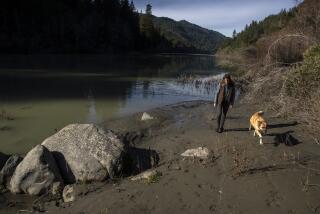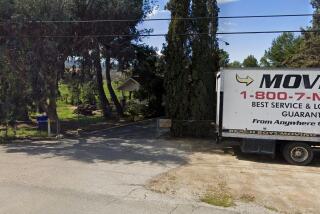Bones Might Give Historians a Break
MILL VALLEY, Calif. â The discovery of two 19th century coffins under the oldest house in this wealthy Marin County enclave has led to speculation that one skeleton could be that of the townâs founder, John Thomas Reed.
Reedâs remains, buried after his death in 1843 at the Mission San Rafael Archangel cemetery, were supposed to have been moved to nearby Mount Olivet Cemetery about 1880, but no one has ever found the grave.
When the coffins were discovered in Mill Valley about two months ago buried under a historic knoll-top estate on Manor Terrace -- part of Reedâs original rancho and just three blocks from his former adobe home -- speculation immediately began that the bones belonged to Reed.
Now, according to Marin County Coroner Ken Holmes, the riddle might be solved. Following news reports about the discovery, a woman who said she was a seventh-generation descendant of Reed contacted the coronerâs office, Holmes said. If someone can come up with about $2,000, her DNA could be tested.
âThey volunteered to provide samples if there is some way to do a DNA check,â he said. âIf the [Reed] family or the homeowner or an anonymous donor or the city of Mill Valley would come forward [with funds to pay for the test], it might be possible to link the remainsâ to Reed.
Holmes said neither his office nor the county would pay for such a test because there were no law enforcement issues surrounding the discovery of the two coffins and a few bone fragments of a third individual. All of the remains, he said, resulted from deaths more than a century ago.
The coroner was quick to note that he has never suggested that any of the remains are those of Reed, the first white settler in Marin.
âThe speculation has been in the media, and they have as much clarity on this as anyone,â Holmes said. âSomeone was buried there 160 years ago. There were people traveling through the area at the time, and if they died, they generally got buried where they died. Right now, I can stand back and say it could be Reed or it could be someone else.â
Human bones turn up on average about once a month in the county, he said, but they are almost always those of the Native Americans who first settled the area north of the Golden Gate Bridge. âBut as far as finding the remains of early settlers who were Caucasian, thereâs been nothing like this in my 30 yearsâ with the coronerâs office, Holmes said.
The mystery began in April when Sean and Jocelyn Connolly bought the Manor Terrace house, built about 1885. Records indicate the estate first was owned by Reedâs widow, Hilaria Sanchez Reed, and her second husband, Barnardino Garcia, reputed to be the infamous bandit âThree-Fingered Jack.â
The Connollys hired a contractor, Pete McKenzie of Maverick Construction, to rebuild the foundation. On April 21, workers were digging out the crawl space for an engineering inspection when McKenzie received a frantic call from a Spanish-speaking crew member.
Not understanding clearly what the problem was, he rushed to the work site, crawled under the house and found a redwood coffin in which a skull and bones lay. âIt scared me to death,â McKenzie said. âI got out of there real fast and called 911.â
The bones in the first coffin were clothed in a fine wool suit with a silk lining and several glass buttons, Holmes said. The bones indicated the man was 5 feet 7 to 5 feet 10 and probably in his late 30s or early 40s when he died.
Reed, an Irishman, arrived in Marin in 1826, eventually obtaining a Mexican land grant for Rancho Corte Madera del Presidio, a vast holding that included present-day Mill Valley. In 1834, he built an adobe home and a logging mill to supply the Presidio of San Francisco. The town was later named for the mill.
In 1836, he married Hilaria Sanchez, daughter of the presidio commandant. The couple had four children before he died.
Reed was 38 when he bled to death June 29, 1843. Neighbors, trying to treat him after he fell ill, possibly with pneumonia, hit an artery while bleeding him, a common medical practice at the time.
McKenzieâs workers found a second coffin and a third set of partial remains beneath the building in early May, Holmes said. The two coffins were about 40 feet apart and not interred in a pattern.
The second coffin, containing a more badly decomposed male perhaps 18 to 22 years old and about 6 feet tall, appeared to have been buried earlier than the first one, Holmes said.
Holmes said all the burials probably took place before the house was built on the promontory, called Cypress Knoll.
Sean Connolly said that when he received the first call from McKenzie -- who initiated the conversation by asking whether Connolly was sitting down -- he expected to be told that âsomething really bad happened to the house.â But when he heard about the coffins, he felt relieved after learning âit was a person laid to rest on a beautiful knollâ more than a century earlier.
Jocelyn Connolly said recently that she wasnât bothered by the fact that people had been buried on the property.
âLetâs face it. If the body was three years old in a bag filled with lime, it would be a different story,â she said. âBut I think itâs kind of a wonderful thing that the knoll they chose is such a beautiful spot and that we can help preserve this part of history.â
Sean Connolly, a vice president for a vitamin manufacturer in Fremont, Calif., and his wife said they would be delighted if any of the bones were identified as Reedâs and could be returned to his descendants for burial elsewhere.
More to Read
Sign up for Essential California
The most important California stories and recommendations in your inbox every morning.
You may occasionally receive promotional content from the Los Angeles Times.










